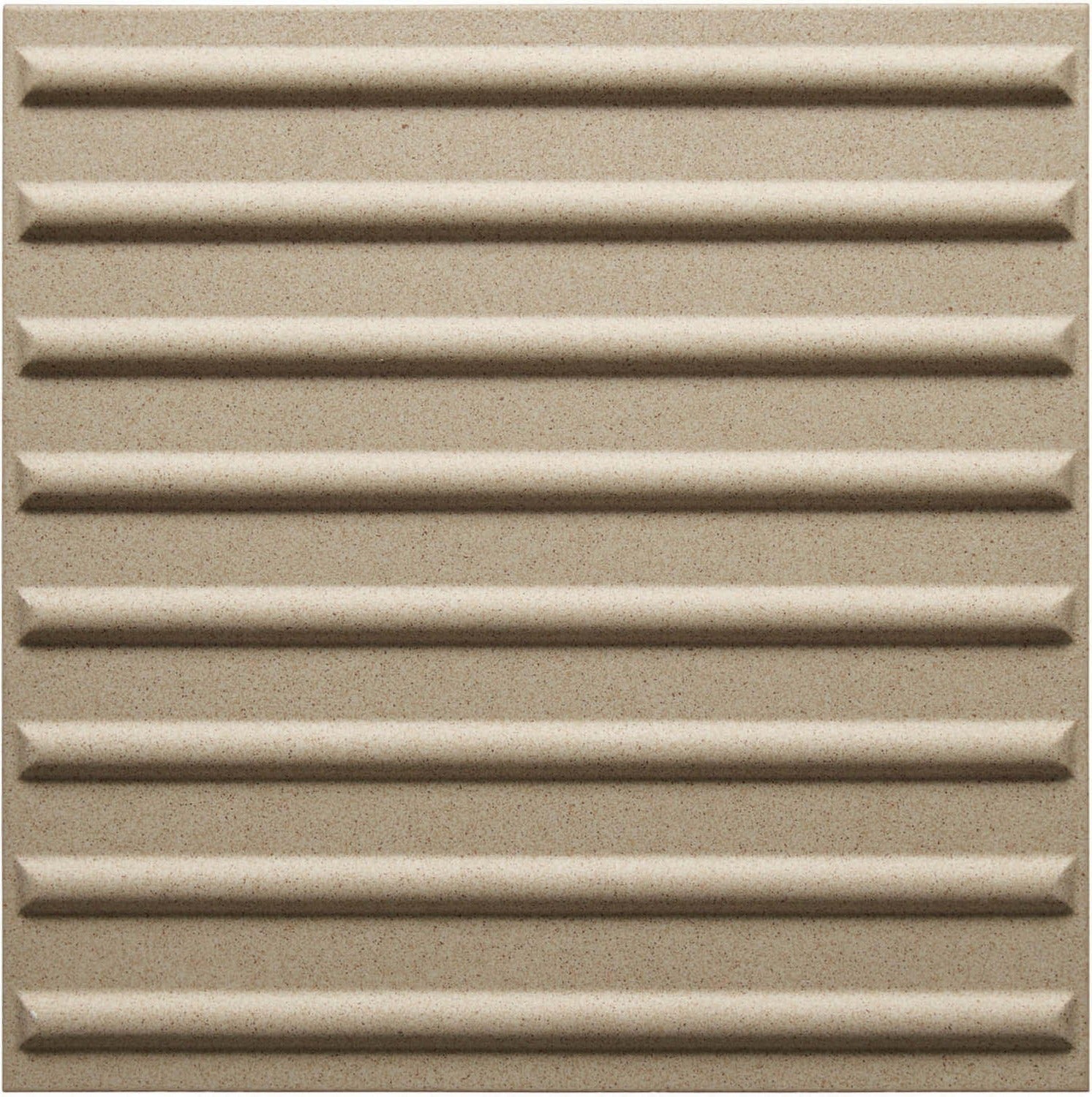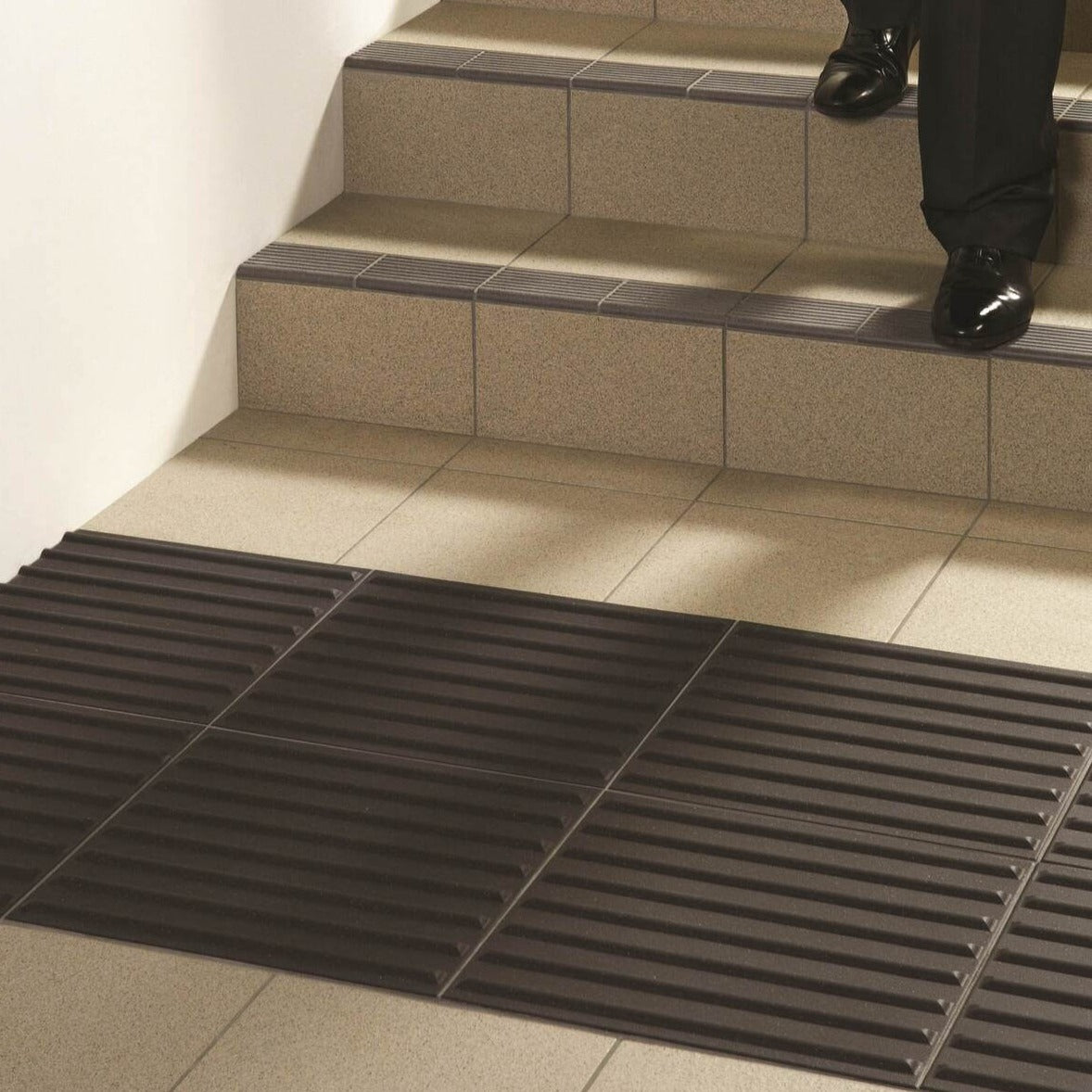Description
High-profile tactile finish.
400 x 400 x 12.5mm • 6.2pcs/27.9 kg per m2
Like Tactile Blister, Tactile Corduroy contains porcelain aggregate throughout the tile body, for hard wearing and sustainable qualities. The Corduroy profile is designed to warn visually impaired people of the presence of specific hazards and implies ‘proceed with caution’. The two shades are contrasting colours which meet current building regulations for LRV contrasting variance. Features include:
- Thickness of 12.5mm for very heavy traffic areas
- Meets the requirements of the Joint Mobility Unit of the RNIB, DETR and the CAE
- Exceptional performance and safety standards
- 'Blister' option also available
- Network Rail approved
- No colour fading in UV light
Download technical guides from here.
Specifications:
| Material: | Porcelain |
| Colour: | |
| Dimensions: | 400x400x12mm |
| Thickness: | 12 mm |
| Finish: | Textured |
The Dorset Woolliscroft brand has a fine pedigree associated with tile making going back as far as 1873.
The products in the range meet and exceed industry standards for technical flooring and are subject to regular in-house and independent testing to ensure continuity of quality.
The client base includes Network Rail and most of the UK train operators and contractors, Transport for London, retailers, commercial hospitality establishments and local authorities for social housing and leisure centres including swimming pools.
Safety Flooring
The message from the Health and Safety Executive is clear: slips and trips are bad for people and damaging for business.
Personal injuries such as fractures, burns and worse can result in pain and days off sick. Businesses suffer from staff being away from work and potential hefty insurance claims against them for causing the injuries. Contributing factors to slips include unsuitable or wrongly specified flooring, contamination, spillages and poor housekeeping. Universal accessibility requirements mean that premises which are places of work and also other non-domestic premises have to be safe for all people including wheelchair users, people with limited mobility and those who have visual impairments.
Reducing as many risks for slips and falls as possible is in everyone’s best interests. Specifying the right floor materials for new buildings as well as modifications, extensions and conversions is a good place to start.
Which type of safety flooring?
That’s a big question. The answer depends on so many factors: Where is it being installed, who will be using it and what will they be doing there? Is it inside or outside or is it for an entrance? Will the conditions be dry or wet or both? Are there ramps and/or stairs involved? The list goes on.
Dorset Quarry Tiles
Dorset Woolliscroft tiles, tactiles and fittings are specifically designed as technical flooring tiles. There are a range of finishes for different environments, from those suitable for wet barefoot areas (such as around swimming pools and changing rooms) to tiles with enough abrasiveness to be suitable for steps and ramps in all-weather locations (such as busy railway walkways, overhead bridges and concourses).
If you know what you’re looking for access the individual product pages left. If you need some advice, call or email and we’ll get back to you to discuss your project and how we can help.
Movement Joints
For interior or exterior floor tile installations, movement joints should be located:
- over existing structural movement joints
- around the perimeter of the floor and where tiling abuts columns, curbs, steps and plant fixed to the base
- in large floor areas tiling should be divided into bays not exceeding 8-10m intervals. On suspended floors the bay size should be reduced and additional joints provided over supporting walls and beams
All floor tile joints should extend throughout the depth of the tile, bed and screed and should be 6-10mm in width.
They should be designed to avoid being subjected to the effect of wheeled traffic and where this is not possible metal reinforced joints should be specified.
Grout: highly pigmented grout may stain the tiles. Always test before installation.
After Fixing
It is the responsibility of the owner to provide for routine inspection, appropriate maintenance, and to assure compatibility of all cleaning methods/ products with grout and mortar manufacturers. Appropriate maintenance requirements are determined by the site environment and the specific use of the installation. All damaging contaminants must be removed from grout joints sufficiently and regularly to avoid permanent damage from exposure to food, biological waste, industrial chemicals and aggressive cleaning solutions. Consult manufacturers for recommended procedures.
They should be designed to avoid being subjected to the effect of wheeled traffic and where this is not possible metal reinforced joints should be specified.
Cleaning
Newly Laid Floors
There may be residual cement on the tile surface of newly laid floors. All traces of this must be removed by applying a mildly acidic decementing solution, which must be rinsed off thoroughly. Clean regularly as specified below.
Regular Cleaning
Regular cleaning with warm water (or hot water for oil and grease) and a neutral or mildly alkaline (pH to 8) detergent will remove all but the most stubborn dirt. Mix the detergent as recommended by the manufacturer. The water/detergent mixture must be left on the floor for enough time (5-15 minutes) to allow it to penetrate and emulsify the dirt. Rinse thoroughly with clean water to remove all traces of the detergent mixture.
Large areas of plain or textured surface tiles are best cleaned with rotary, cylindrical or reversing mechanical scrubbing machines as follows:
- Use slow to medium speed rotation. If the machine has a suction drying facility, use it first with the suction facility switched OFF. This permits the water detergent mixture used in the scrubbing process to remain on the floor to penetrate the dirt layer.
- Leave for at least 5-15 minutes to elapse, then repeat the scrubbing operation with clean water only and with the suction drying facility switched ON. It is the rinsing process which removes the dirt.
- Spillages of oil, fat or any material likely to stain or cause a slipping hazard should be removed immediately by using detergent and hot water, followed by a cold water rinse.
- Use warning signs or physically exclude people from wet cleaning areas until they are completely dry.
Longer Term Maintenance
Clean the floor periodically using a rotary, cylindrical or reversing scrubbing machine with the addition of an abrasive powder or fine Silica Sand. These products scour the tiles, remove impacted dirt, and generally refresh the floor without damaging their surface. Remove the residue with clean water and rinse before it can dry out. If high velocity water jets are used for removal of stubborn dirt this will not damage the tiles, but may erode the joints if used regularly. If oil or grease is present, use the jet with warm or hot water and with a pH neutral detergent.
Please note that marks made during installation and with constant use may be more obvious on pale colours. Therefore even Dorset Woolliscroft fully vitrified tiles will require a certain amount of extra cleaning in areas prone to heavy soiling.
NB. These cleaning and maintenance instructions are Dorset Woolliscroft’s recommendations and not necessarily exhaustive. The recommendations of manufacturers of cleaning equipment and materials should always be followed.
Download the complete Dorset Woolliscroft Brochure HERE
Shipping
Yes, we offer FREE UK* delivery for all orders over £499.
*If your order is below that, and if you live in Northern Ireland, certain parts of Scotland, and the Channel Islands, please check our Delivery Info Page.
We have most of our products in stock and we offer a Standard (3-10 working days) and Express (3-4 working days) delivery.
Sample shipping takes up to 7 working days.
For products that are not in stock, we will call/email the customer to let him know of a longer waiting time (up to 30 days), in which case, he has the option to either keep the order or ask for a full refund.
We offer samples only for Dorset Flat Tiles, however, we might be able to send out a sample for some of the other Dorset tiles too. Please contact us 01633875003 or sales@tilesahead.co.uk
Any question?
If we still haven't answered your question, you can contact us below and we will get back to you as soon as possible.


